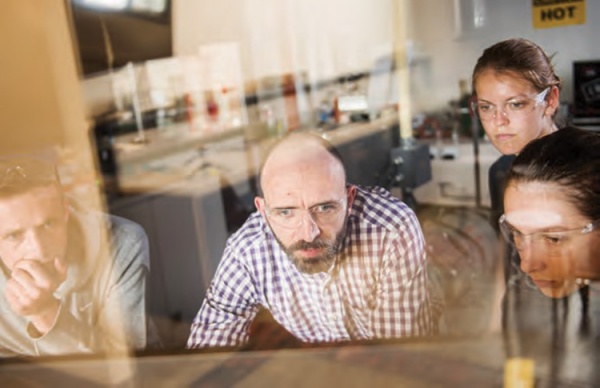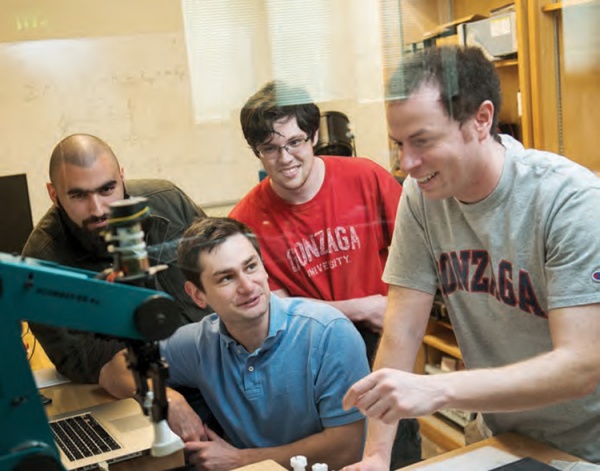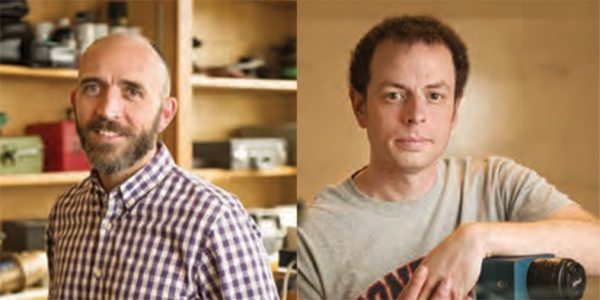Profiled alongside one another in Gonzaga’s 2014-15 School of Engineering and Applied Science year-in-review as new faculty members, mechanical engineering assistant professors Marc Baumgardner, Ph.D., and Timothy Fitzgerald, Ph.D., moved into adjacent offices and labs and quickly formed a relationship that exemplifies the collaborative and supportive nature of the school.
“We met on day one of faculty orientation,” said Fitzgerald. “We have complimentary skill sets — I have a background in computational models and measurement techniques, which have been useful in his experiments.”
“Also, we have similar vision about where we see ourselves and the department going in the future,” added Baumgardner.
Fitzgerald’s work concentrates on analysis of wings in flight; he is currently performing a series of experiments to capture the deformation of the wings of free-flying insects. Baumgardner’s work focuses on combustion, engines, fuels and systems that lead to cleaner burning. As he put it, “we shoot lasers at fire.”

Most of Dr. Marc Baumgardner’s current work focuses on the combustion of biofuels and/or renewable fuels.
Drawn to Gonzaga for the small class sizes, work-life considerations and balance between emphases on teaching and research, both professors fell in love with the many opportunities Spokane provides with respect to family-friendliness and outdoor activities.
“I love to get out and cycle,” said Baumgardner.
“He pulled me into that one,” admitted Fitzgerald, “and now I commute most days to work by bike.” In addition to their common love of the outdoors, Fitzgerald and Baumgardner both agree on what sets Gonzaga’s mechanical engineering department apart.
“It’s us!” joked Fitzgerald.
“We’re nothing if not modest,” Baumgardner interjected, with a smile. Fitzgerald continued, “Really, it’s the atmosphere in which everyone, from the dean to department chairs, staff and instructors, cares so much about our students and wants to make the program better as engineering as a discipline evolves.”
“There is a general cohesiveness in the department,” said Baumgardner. “Also, we have a big project space for students and are actively trying to grow opportunities for more. I think having a mix of well-defined projects and open-ended projects along with the facilities to accommodate them helps to motivate everyone.”
According to Fitzgerald, student-led collaborative experiments, supported by theory and computation are at the heart of a successful engineering education. Baumgardner believes that these opportunities can help Gonzaga’s engineering students become more competitive with other programs around the country. Both professors agree that Gonzaga’s well-rounded core curriculum, paired with an outstanding technical engineering program, truly makes a difference for students.
“The technical acumen,” said Fitzgerald, “and the presence of person that a liberal arts foundation imbibes translate to great people skills later on.”

One of Dr. Tim Fitzgerald’s current research projects is on analysis of wings in flight: part of experimental characterization of biological systems.
One of Baumgardner’s students made an impression with those skills recently while studying abroad in Zambia. The student sent an email from Africa to Baumgardner, sharing his experience teaching thermodynamics to local children.
“Teaching thermo in Africa!” Baumgardner exclaimed, “That was so heartwarming. I appreciate being able to build rapport with students, whether through the senior capstone projects or the intentional and intensive advising we do here. Watching the progression and then seeing them find jobs and go off to become productive members of society has been rewarding.”
For both professors, the hope is that each and every class leads students to have a stronger ability to handle difficult or complex problems — breaking down every big problem into sequences of smaller problems that can be approached one at a time with confidence. They also emphasize asking questions and understanding that there may not always be answers, viewing these as core elements of Gonzaga’s Jesuit mission.
Baumgardner noted that, “The potential is great to teach engineering in context, helping the world around us — that is what we do.”
“Our mission provides a wonderful vehicle to give context to the technical minutia in solving problems,” agreed Fitzgerald. “It’s what gets me out of bed in the morning to come to work — being able to work on cool problems that matter and have a real impact. Go forth and set the world on fire — just not literally.”
“For my lab, that actually works,” Baumgardner chuckled, “we burn things every day.”
